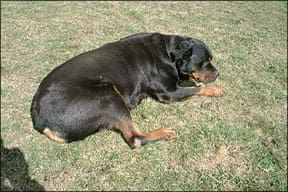Despite everything modern medicine has to offer, cancer remains among the most feared of canine diseases.
Just over a year ago, Whole Dog Journal reviewed conventional, complementary, and alternative cancer therapies in a series of articles (“Canine Cancer Crisis,” November 2005; “Conventional Cancer Care,” December 2005; “Don’t Despair, Just Care,” January 2006, and “What Are the Alternatives?” February 2006) Since then, a cancer vaccine has been approved for veterinary use and a new version of an old herbal salve has become a “first choice” for many holistic veterinarians. Here’s what’s new.
Melanoma vaccine
Most vaccines are designed for prevention, but a new type is designed to treat active disease. The U.S. Department of Agriculture recently approved such a vaccine for the treatment of canine melanoma.

288
“Everything about this vaccine is unusual,” says Gerald Post, DVM, a Norwalk, Connecticut, veterinary oncologist and founder of the Animal Cancer Foundation. “In addition to being therapeutic rather than preventative, it contains human DNA. Injecting an animal with DNA from a different species can effectively stimulate an immune response that attacks cancer cells.”
The vaccine is a result of collaboration between human and veterinary oncologists at the Animal Medical Center in New York City, Memorial Sloan-Kettering Cancer Institute, and the drug’s manufacturer, Merial.
Melanomas are usually solitary black tumors, and those appearing on the mouth or nail bed are usually malignant. Dr. Post understood the prospects all too well when, four years ago, he noticed a tiny lesion on one the toes of his own Miniature Schnauzer, Smokey.
“It was metastatic melanoma,” says Dr. Post. “When I saw the x-rays and biopsy report, I was devastated. It had already spread to his lungs, and the average survival time for dogs with this type of cancer is about three months.”
Smokey, who was 12½ years old at the time, was such a healthy, vibrant dog that Dr. Post worked frantically to save him.
“At that time the melanoma vaccine was still very new and experimental,” he says, “but I didn’t hesitate to try it as everyone I consulted agreed that it looked like our best hope. I was really pleased when he lived an additional two and a half years. The vaccine didn’t cure him, and eventually the tumor came back, but it gave him extra time and an excellent quality of life. The result was far more than I had dared to hope for when I first made the diagnosis.”
Dr. Post was particularly pleased because Smokey never experienced an adverse side effect. “In the beginning Smokey received the vaccine every two weeks for two months,” he says. “After that, he got it once a month or so. Smokey responded really well, and throughout his therapy, you would never know that anything was wrong or that he was under any kind of treatment.”
In this respect, Smokey was like most patients. “I’m loathe to say that no dog will ever have an adverse side effect,” says Dr. Post, “but adverse reactions are very, very rare. None of the 50 or more dogs that I sent to the Animal Medical Center to receive the vaccine over a period of four to five years experienced any adverse side effects that I’m aware of.”
According to Dr. Post, the ideal candidate for the melanoma vaccine is a dog whose condition is discovered early, before it metastasizes, when it can be well controlled locally. “Obviously,” he says, “the earlier you find the disease, the better. You don’t want to wait until it has spread.”
In March 2007, the USDA issued a conditional U.S. Veterinary Biological Product License for the vaccine. During the conditional licensure period, Merial will conduct additional research supporting the vaccine’s safety and effectiveness. During this time, it will be distributed by veterinary oncologists.
“I’m excited about the release of this vaccine,” says Dr. Post, “because it’s exactly the kind of medical breakthrough that the Animal Cancer Foundation was created to fund. It’s an innovative, novel therapy, it treats a really serious problem, it’s effective, and it helps not only dogs but people, too. The same technology that created the canine melanoma vaccine is being researched for human melanoma.”
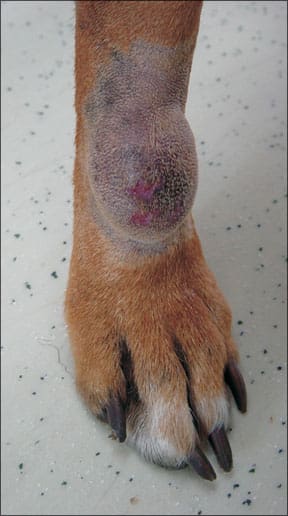
167
Neoplasene
Our February 2006 article (“What Are the Alternatives?”) on alternative cancer treatments described bloodroot salves, also called black salves, which have been used in the treatment of many types of cancer in humans, dogs, cats, horses, cattle, and other animals. Salves containing bloodroot (Sanguinaria canadensis) are red when first made but turn dark or black with age, hence their common name.
Herbal treatments are popular because they are inexpensive (or at least less expensive than conventional treatments) and they are usually gentle, easy to use, and unlikely to cause adverse side effects.
“Bloodroot salves are generally less expensive than chemotherapy or radiation,” says Deborah Cihonski, PhD, founder of a black salve Internet forum, “but that’s where their similarity to other herbal therapies ends. Bloodroot salves are rarely gentle, and I always recommend that a veterinarian supervise treatment.” Dr. Cihonski, a pediatric psychologist who lives in Tampa, Florida, and Chicago, first heard of black salves from her Chicago veterinarian, Kimberly Curtis, DVM, when her young cat, Piper, was being treated for vaccine-associated fibrosarcoma.
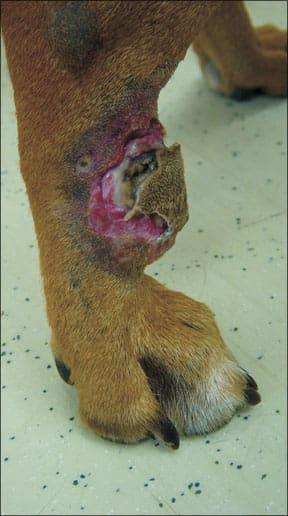
167
“I had taken him to the University of Illinois veterinary oncology department,” she says, “and they said there wasn’t much they could do for his long-term survival. They suggested a very expensive treatment that involved leaving him there for nearly two months of radiation, chemo, and bone-removal surgery. This, they hoped, would allow him to live another three years at most.” Dr. Cihonski had lost several dogs to cancer after aggressive and heroic treatments. “These rarely worked out to anyone’s favor,” she says, “so I was open to alternatives for Piper.”
Piper had received several months of herbal therapy when Dr. Curtis mentioned hearing about black salve, which she thought might be helpful for him. Dr. Curtis discovered Neoplasene and consulted with its manufacturer, Terry Fox, PhD, at Buck Mountain Botanicals in Miles City, Montana.
Traditional black salves are made with zinc chloride, a caustic chemical that burns the skin. In contrast, Dr. Fox uses zinc chloride to make a highly ionic solvent with which he extracts bloodroot’s isoquinoline alkaloids. Although it is used in Neoplasene’s production, zinc chloride is not contained in the final product. Neoplasene’s bloodroot alkaloids comprise a small but vital portion of its ingredients. According to Dr. Fox, the isoquinoline alkaloids are modified in such a way as to cause diseased tissue to self-destruct preferentially, sparing healthy, normal non-cancerous tissue.
Four forms
There are four Neoplasene products: Neoplasene salve (which is also known as Sarcoma #1) for topical application; Neoplasene oral; and two types of NeoplaseneX for intravenous use or injection directly into tumors.
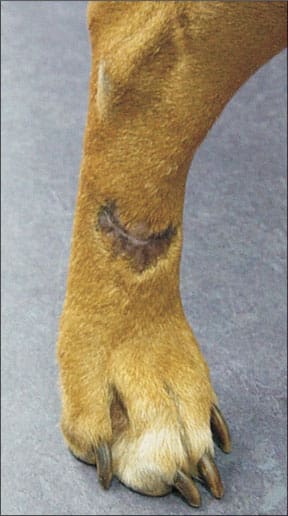
167
Dr. Curtis and Dr. Cihonski used Neoplasene salve to remove Piper’s tumor, then switched to oral Neoplasene to complete his treatment.
“We did the same thing with my pet chicken, who had major tumors that were very vascular,” says Dr. Cihonski. “We almost lost her in surgery so we had to explore other treatment options. The results were successful in both cases.”
Throughout her study of alternative cancer therapies, she kept wishing that Neoplasene had been available years ago, when her Rottweilers suffered from osteosarcoma, hemangiosarcoma, and malignant histiocytosis. “I kept thinking that this could have helped them when nothing else did.”
One year ago, Jackie, a three-year-old Jack Russell Terrier belonging to Dr. Cihonski’s mother, Phyllis Cihonski, developed a tumor on her foot. “It was diagnosed as a histiocytoma,” says Mrs. Cihonski. “These are most frequently benign and often disappear spontaneously. The only prescribed treatment was antibiotics for infection, and if necessary, the toe would be removed. I felt that treatment with the oral Neoplasene was preventative. Within days of beginning the treatment the tumor regressed and then disappeared. Jackie is a happy, active dog, and she still has all of her toes.”
Although the application of Neoplasene is easy, Dr. Cihonski warns that it is best used by an informed consumer with the assistance of an experienced veterinarian. “The results are simply beyond what most people expect,” she explains, “especially the topical salve. When a tumor falls off, it can leave a huge wound behind, and that can be very frightening. This was certainly true in the case of my own animals, whose wounds looked awful. However, the wounds never became infected even though I didn’t treat them with antibiotics or disinfectants. I just kept them clean and lubricated.”
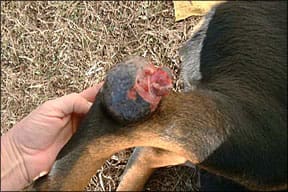
288
Lubricating salves or oils help speed healing and keep skin pliable.
It makes sense, says Dr. Cihonski, to start with oral Neoplasene because some tumors respond quickly, sparing patient and caregiver the inconvenience of extensive wound care. “You won’t know until you try what the results will be,” she says. “My chicken responded well to oral Neoplasene, but it did nothing for my cat. Some dogs get immediate results and others don’t. In some cases of very aggressive or advanced tumors, topical application is the best line of defense.
“In some cases,” she continues, “animal guardians have given their dogs oral, topical, or injected Neoplasene only to produce dramatic results that they did not consider positive. Some have stopped treatment altogether. The same is true for chemotherapy and radiation. When you’re dealing with cancer, you’re dealing with a serious, complicated illness. I wish there were a works-for-everything cancer treatment that is gentle, easy to use, 100 percent effective, entirely free from side effects, and painless, but if there is, I haven’t found it.”
For those interested in using Neoplasene, says Dr. Cihonski, the choice of treatment depends on the patient, the type of cancer, its location, and its stage of growth.
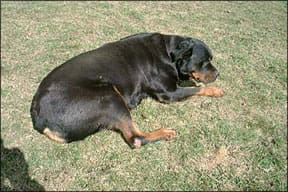
288
“For example,” she says, “if you’re treating a squamous cell carcinoma in the mouth, you may not have time to give the oral dosing and wait to see what happens. Some tumors are so fast-growing that you can literally watch them increase in size from one day to the next. If you start with oral Neoplasene and don’t see results right away, you can switch to the topical salve, which works immediately. Multiple treatments are often required at 7- to 14-day intervals. The same is true for Neoplasene that’s injected into tumors.”
Clinical guide
To help veterinarians use Neoplasene correctly and help their clients understand what to expect, Dr. Fox provides a clinical guide for the treatment of neoplasm (abnormal tissue growth or tumors), proud flesh (soft, swollen, granulated tissue that develops over large surface wounds, especially in horses), and warts. Instructions for use precede case histories from a dozen holistic veterinarians, complete with graphic photos.
Conventional cancer treatments like surgery, chemotherapy, and radiation therapy often fail to remove or destroy active cancer cells while they simultaneously damage healthy, nonmalignant tissue.
“This often leads to failure,” says Dr. Fox, “and the stoic acceptance that all that can be done has now been done, and euthanasia or animal suffering is inevitable. What has been needed is a drug that causes the destruction of all neoplasm, preferentially sparing healthy cells. Neoplasene’s isoquinaline alkaloids appear to present just this effect.”
According to Dr. Fox, the active principle in bloodroot’s main alkaloid, sanguinarine, interacts with DNA while inhibiting adenosine triphosphatase. “These and other demonstrated mechanisms offer clues to the ‘how does it work on neoplasm?’ questions,” he says. “There is a functional relationship between the death of neoplastic cells and exposure to Neoplasene.”
The cases documented in Neoplasene’s clinical guide include sarcoma, melanoma, osteosarcoma, mammary tumors, malignant liposarcoma, mixed cell chest tumors, malignant fibrosarcoma, papilliferous cyst-adenocinoma, nerve sheath tumors, spindle cell carcinoma, and various other tumors and growths in dogs, cats, and horses. The graphic color photos that accompany the case studies put wound treatment warnings into perspective; this therapy is not for the faint of heart.
Not without side effects
“I’ve been using Neoplasene for a year now,” says Linda Faris, DVM, of Overland Park, Kansas, “and I’m very impressed with the results. My preference is definitely for the oral product. This is a liquid that you place in a capsule just before giving it to the pet with food. I usually give my clients enough to treat their animals for a month and then check on their progress.”
Dr. Faris acknowledges that injectable NeoplaseneX and topical Neoplasene can be highly effective, but she approaches both with reservations. “I’ve used the injectable version with mixed results,” she says. “For a couple of my patients it proved too caustic, and they had anaphylactic reactions. These reactions seem linked to repeated exposure and individual sensitivities, but in general, I think the chances of having an adverse reaction are greater for the injectable or intravenous version. I’m also reluctant to use the topical salve because of resulting wound care management issues.”
The most common side effect that Dr. Faris’s patients experience with oral Neoplasene is nausea. “Some pets throw it up soon after they swallow it,” she says. “That’s the only adverse effect I’ve seen, and we either lower the dose or stop the treatment for those animals. In some cases, if we stop treatment for a while, we are able to start it back up with no problem.”
Occasionally, Neoplasene is Dr. Faris’s first choice for economic reasons. “Some clients are on such a tight budget,” she says, “that other treatments are just not affordable. Neoplasene isn’t free, but it’s far less expensive than conventional cancer therapies and most alternatives.”
One of her favorite success stories involves a small female Poodle with perineal adenocarcinoma that was impinging on her rectal canal. Thanks to oral Neoplasene, the tumor softened and shrank, and the dog is doing well.
“This was a serious case,” says Dr. Faris, “because the tumor was beginning to interfere with her ability to defecate. Within a month, the tumor had softened and changed shape, and with continued oral Neoplasene, it shrank. She’s now on a maintenance dose of a small amount three times a day, and sometimes she only gets it twice a day. The prescription is for one-third of a c.c. every eight hours, and that’s all this dog is on.”
Holistic treatment required
For the dog’s caregivers, an effective treatment that’s easy to administer and costs only $40 per month is a blessing.
More typical of Dr. Faris’s patients is a Chow Chow with very advanced metastatic liver cancer. A multi-pronged approach is most effective in severe or advanced cases like hers.
“We’re using several different treatments, not just Neoplasene, to try to manage the cancer,” Dr. Faris says. “Last August the dog was given a 30-day prognosis, her condition was so serious. The surgeons who opened her up decided not to operate. Instead, they sent her home to die.
“Today, eight months later, you can’t tell she’s ever been sick. She honestly shows no symptoms. Her blood work is a mess, but you’d never know that by looking at her. She’s active, happy, and leading a perfectly normal life. She has had to go off the Neoplasene a couple of times because of digestive upsets, but she’s on it most of the time, along with Chinese herbs, glutathione therapy, alpha lipoic acid, liver support products like milk thistle, and a few other things.”
All of Dr. Faris’s cancer patients are on a no-grain diet that’s as low in carbohydrates as possible. “I find that really makes a difference,” she says.
Whenever she sees a cancer patient, Dr. Faris’s goal is to extend the animal’s life while improving the quality of that life. “Some dogs with cancer don’t come to me until they’re at end stage,” she says. “Unfortunately, I’m not able to do much except ease their transition. But those who come to me in time typically do very well.”
Spreading the word
In addition to seeing her own patients, Dr. Faris consults with veterinarians around the world.
“In one case a woman in Great Britain got in touch with me because of an article I’d written about a case similar to that of her Northern Inuit. The dog had advanced histiocytic sarcoma, with large tumors that were actually rotting on her body. She had already been put on chemotherapy, but it made her so ill that they had to stop.
“Through the help of her local veterinarian, we were able to put the dog on Neoplasene and European mistletoe, another herb with cancer-fighting properties. That dog is a miracle. The tumors have all healed and regressed to nothing. Now, just a few months after she started treatment, you can’t tell she has cancer.”
For as long as people have been experimenting with black salves, some have taken them orally once or twice a year as a cancer prevention therapy. Dr. Faris considers a similar use of oral Neoplasene a sensible strategy for dogs at high risk of developing cancer or experiencing a recurrence.
According to Dr. Fox, since its introduction four years ago, over 2,000 veterinarians worldwide, most of them in the United States and Canada, have prescribed Neoplasene for their cancer patients. “Considering that a single jar of the salve will treat 80 cats or a large number of dogs,” he says, “this is a very affordable therapy.”
In August 2006, New York City veterinarian Jill Elliot, DVM, told the New York Post that Neoplasene was changing her medical practice. One of her patients, a 10-year-old Belgian Shepherd named Athos, had been given six months to live by oncologists who removed his cancerous tumor. Dr. Elliot combined conventional and homeopathic treatments to keep Athos in remission until July 2006, when a new tumor appeared.
Dr. Elliot injected the growth with NeoplaseneX, and almost immediately, the tumor began turning white. “About five hours later,” she said, “the sick tissue was literally dying and dripping off. This is so miraculous that I’m fully endorsing Neoplasene. With results like this, it’s worth devoting the rest of my practice to it.”
CJ Puotinen is author of The Encyclopedia of Natural Pet Care, Natural Remedies for Dogs and Cats, and other books. She lives in New York with her husband, a Labrador, and a tabby cat.


